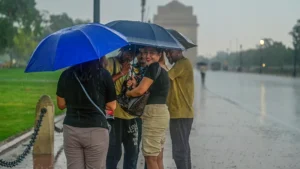How to Weatherproof Your Next Holiday: The New Face of Travel Insurance in a Changing Climate

Travel has always come with a measure of uncertainty. But in recent years, the unpredictable has become the expected. Floods in South Asia, historic heatwaves across Europe, hurricanes battering the Americas – extreme weather is now a real and rising risk to travellers everywhere. This shifting reality has pushed travel insurers to reconsider what protection truly means.
Gone are the days when travel insurance was just about flight delays and medical emergencies. As the climate changes, a new wave of insurance products is emerging to “weatherproof” holidays, offering travellers peace of mind even when skies turn stormy or temperatures soar.

The rise of “everyday disruption” coverage
Historically, travel insurance focused on major crises: hospitalisation abroad, natural disasters, or airline bankruptcies. Yet for most holidaymakers, it’s often less dramatic but still disappointing events that ruin trips: a week of rain at the beach, an unexpected heatwave turning sightseeing into a struggle, or missed ports on cruises due to rough seas.
Recognising this gap, insurers have begun offering products that specifically cover these everyday disruptions. One example is WeatherPromise, a company that provides payouts if rainfall during your trip exceeds a set threshold. This means if you plan a beach holiday and end up sheltering indoors for days, you could receive compensation.
Daniel Price, co-founder of WeatherPromise, explains: “The number one factor that causes someone to come back disappointed isn’t usually a catastrophe; it’s the weather simply not cooperating. People don’t just buy trips—they buy the experience they imagine. Rain or extreme heat can take that away.”
Expanding beyond rain: heatwaves, snow, and beyond
Rain insurance is just the start. Recent European heatwaves, with temperatures topping 40°C in cities like Rome and Paris, have prompted insurers to explore heatwave coverage. After all, extreme heat can be as disruptive as storms: forcing cancellations of outdoor tours, making sightseeing unsafe, and even causing health issues.
Other niche products have emerged too. In Japan, some ski resorts experimented with “snow insurance,” refunding customers if snowfall was insufficient for skiing. In the Caribbean, hurricane season coverage has become common, offering refunds or rebooking if storms threaten.
These products share a common philosophy: travel disruption isn’t always about disasters. Even non-life-threatening weather can fundamentally change a holiday experience.
Why travellers want more flexibility
The Covid-19 pandemic reshaped how people think about risk. Millions faced sudden border closures, lockdowns, and quarantines. Since then, more travellers choose flexible booking options and purchase insurance add-ons like “Cancel for Any Reason” (CFAR) coverage.
CFAR policies often reimburse around 50–75% of prepaid expenses if you cancel your trip for almost any reason. While pricier than standard insurance, they give travellers power to decide when a trip no longer feels right—whether due to a looming storm or even a personal change of plans.
Chrissy Valdez from SquareMouth, a travel insurance comparison site, notes: “Post-pandemic, travellers are more conscious that plans can change quickly. They want policies that adapt, not just ones that cover worst-case scenarios.”
Real-life examples of disrupted travel
Consider the 18 trekkers who flew into Nepal in September 2024, aiming for Everest Base Camp. Heavy rain hit Kathmandu Valley, flooding roads and grounding flights. The group wasn’t in direct danger—but the trek became impossible. While some travellers’ insurance covered extra nights in Kathmandu, none offered refunds for the cancelled bucket list adventure.
Or think of European tourists in summer 2023, caught in record-breaking heat. Walking tours in Athens were cancelled, local authorities closed popular attractions like the Acropolis during peak heat hours, and medical emergencies rose sharply. For many, the holiday they’d imagined became impossible.
Such stories highlight the gap between traditional insurance and modern travel realities.
Beyond weather: “comfort” as an insurable factor
New insurance products go further, covering not just weather but comfort. Imagine checking into a hotel during a European heatwave and discovering it lacks air conditioning—a surprisingly common issue in older European buildings. Some policies now allow you to claim trip interruption if your accommodation becomes uncomfortably hot.
Similarly, cruise passengers might claim compensation if a ship misses a scheduled port for reasons beyond their control. It’s all part of a trend: travel insurance that recognises inconvenience, not just danger.
Valdez adds: “Travellers increasingly expect their insurance to match their lifestyle and expectations. They want coverage that protects the experience, not just the logistics.”
The challenge of defining “bad weather”
As useful as these new policies sound, they raise practical questions. What exactly counts as “bad” weather? How many hours of rain qualify for a payout? Does a heatwave mean a specific temperature over a certain number of days?
Every insurer sets different rules. Some require daily rainfall above a threshold; others use local weather station data to verify conditions. Travellers must check these details before buying: coverage only applies if criteria are met, and claims often require documentation.
Valdez warns: “Always read the fine print. Policies vary hugely in what counts as extreme weather or inconvenience.”
Will more insurance lead to higher costs?
Insurers face a delicate balance. Offering broader coverage protects travellers—but also increases risk for the company. As weather becomes less predictable, some underwriters may tighten definitions or raise premiums.
Valdez explains: “Some underwriters already reconsider what ‘extreme’ or ‘inclement’ weather means. If such events become common, insurers might define them more strictly or charge more.”
Travellers need to weigh cost against peace of mind. For many, paying extra for broader coverage makes sense—especially for expensive, once-in-a-lifetime trips.
Technology’s role: real-time weather data
Modern weather insurance often relies on precise data. Companies partner with meteorological services to track rainfall, temperature, and storm alerts almost in real time. Claims can be processed automatically if thresholds are met, reducing disputes.
For example, WeatherPromise doesn’t require travellers to document every rainy day; instead, it monitors local weather data directly. This makes claiming faster and less stressful.
Such innovations mean travel insurance can evolve as quickly as the climate changes.
Climate change and future travel insurance
The insurance industry itself recognises that climate change is rewriting the rules. What used to be rare—record heat, sudden floods, out-of-season storms—is becoming normal. Travel insurers must adapt, or risk offering products that no longer match reality.
For travellers, this means more options—but also more complexity. Choosing the right policy increasingly requires understanding weather risks specific to your destination and season.
Experts suggest researching:
-
Historical weather trends at your destination.
-
Recent extreme events.
-
Fine print in policy definitions.
How to “weatherproof” your own holiday
-
Research your destination’s seasonal risks. Even places known for sunshine can face monsoons, heatwaves, or sudden cold snaps.
-
Choose flexible booking options. Many hotels and airlines now offer refundable or changeable rates.
-
Consider CFAR or weather-specific add-ons. Decide if the cost matches your risk tolerance.
-
Document everything. Keep receipts, photos, and communication with providers, in case you need to claim.
-
Stay informed. Use weather apps and official alerts before and during your trip.
Balancing tourism and sustainability
Increased tourism can support local economies—but also risks harming fragile environments, especially as weather worsens. Sites like Nepal’s trekking routes or ancient monuments in Europe already face pressure from visitor numbers and climate change.
Sustainable travel—like visiting off-peak, supporting local guides, and respecting environmental limits—helps protect destinations for the future.
Looking ahead: peace of mind in an uncertain world
Travel will always involve uncertainty. But as weather patterns shift, new insurance products can help travellers feel confident planning adventures that once seemed too risky.
As Daniel Price from WeatherPromise puts it: “We want people to travel, knowing if it rains all week, their holiday isn’t wasted.”
Meanwhile, experienced guides like Nepal’s Balaram Thapa see these changes as necessary: “Disruption doesn’t always mean danger. Sometimes it just means the trip can’t happen as planned. Insurance needs to recognise that.”
Ultimately, “weatherproofing” your holiday isn’t about expecting perfection. It’s about planning wisely, staying flexible—and knowing that even if the sky turns grey, your adventure doesn’t have to end.




